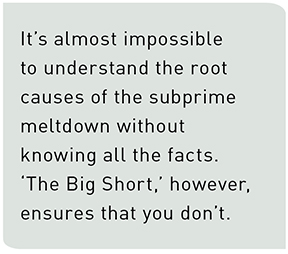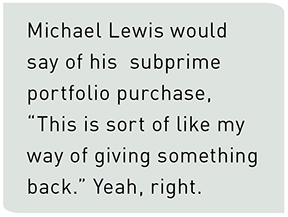HOME | ABOUT US | MEDIA KIT | CONTACT US | INQUIRE
HOME | ABOUT US | MEDIA KIT | CONTACT US | INQUIRE

To give credit where it is due, Hollywood has managed to make a film about the collapse of the international financial system that is halfway enlightening and altogether entertaining. What “The Big Short” does not do, and what Michael Lewis’s excellent book of the same name did not do, is explain how the market came to be flooded with potentially lethal subprime loans in the first place. That is the kind of story Hollywood does not like to tell.
Here is how it all began. When Bill Clinton was inaugurated in 1993, the homeownership rate was lower than it had been when Richard Nixon was inaugurated in 1969. Yet across the political spectrum, everyone agreed that Americans had a veritable manifest destiny to own their own homes.
The numbers, however, were frozen. The decline in two-parent families was negating the increase in prosperity. How could it not? In 1993, the average income for households headed by divorced women was 40 percent that of married couples; for unmarried women, it was only 20 percent. Home-ownership rates for female-headed households struggled to stay above 50 percent. For married couples, they hovered consistently in the 80-percentile range.
With African-Americans overrepresented among single families, white home-ownership rates inevitably outstripped those for black home ownership. In the early 1990s, that gap was at least 25 percentage points, around 70 percent for whites and in the low 40s for blacks.

True to form, the chattering classes refused to acknowledge family breakdown as a problem, let alone as an explanation for the disparity in home-ownership rates. Their preferred explanation for just about everything unpleasant—then as now—was the inevitable racism. Ignoring all contrary evidence, they found what they were looking for in a 1991 study by the Federal Reserve.
According to the study, 61 percent of blacks had been approved in their quest for government-backed home loans, compared to 77 percent for whites. Bingo! The study conceded a lack of information about “the creditworthiness of applicants” as well as “the adequacy of the collateral offered,” but for the media, these limitations were mere quibble.
What other, less-celebrated studies revealed was that during the 1990s, blacks were defaulting on their loans more than twice as frequently as whites, and Hispanics were defaulting three times more frequently—the latter, in a worrisome 13 percent range. Had minorities truly been held to higher standards, their default rates should have been lower than those of whites, not higher.
Another in-depth study of the 1990s concluded that divorced women were “significantly more likely to default than divorced men and married households.” By decade’s end, default rates among divorced women had more than doubled from 1991. This breakdown fed the surge in bankruptcies.
Ignoring the hard data, HUD began to bring legal action against those mortgage bankers who declined a higher percentage of minorities than whites. The regulators were backed by the street-level bullyboy tactics of ACORN, shorthand for Association of Community Organizations for Reform Now. In 1991, ACORN operatives set the stage for their new focus with a two-day takeover of the House Banking Committee hearing room. Historically, banks had been reluctant to offer home loans to people who might not pay them back, and so ACORN set out to embarrass bankers into overcoming that reluctance. The media applauded.
To make ACORN’s task easier, the Clinton administration demanded that banks quantify the progress they were making in giving loans to LMIs—people of low and moderate income. The administration encouraged banks to use “innovative or flexible” lending practices to reach their LMI numbers.
Meanwhile HUD, which Congress had made the regulator of Fannie Mae and Freddie Mac in 1992, began to pressure these agencies to set numerical goals for affordable housing, even if that meant buying subprime mortgages. Countrywide Financial and other less-than-scrupulous lenders were happy to help. In July 1999, Countrywide announced a strategic agreement with Fannie Mae, vowing to allocate “a substantial portion of Countrywide’s agency-eligible production to Fannie Mae.”

A September 1999 New York Times article offered a useful window on the pressures that were being brought to bear on the lending industry. The article blithely cheered on the work of Fannie Mae, then in the process of prodding banks to provide mortgages to those whose credit was “not good enough to qualify for conventional loans.”
With a gun to their head, the lenders turned to Fannie Mae and Freddie Mac to relieve them of the imprudent loans they were now being forced to make. Before the 1990s, Fannie and Freddie had sufficiently tough lending standards that default was not much of an issue. That would change. In 1999 CEO Franklin Delano Raines told the Times that Fannie Mae had lowered the down-payment requirements for a home and now planned to extend credit to borrowers a “notch below its traditional standards.” That notch was spelled subprime.
Given the greater risk, and their inability to shop, subprime prospects typically have had to pay more interest to secure a loan. For investors, high interest translated into high yield. In October 1997, the investment banks Bear Stearns and First Union Capital Markets underwrote the first securitization of subprime loans for a total of $385 million. The triple-A rating of Freddie Mac–approved loans seemed, at least, to guarantee the payments on these securities. The back-patting news release announcing the launch hit all the bubble-era hot buttons: these “affordable” and “flexible” mortgages offered the possibility of credit for “low and moderate income families” in “traditionally underserved markets.”
These securities proved enormously popular. They promised a 7.5 percent yield in a low-interest-rate environment and, if that were not enough, a chance to cleanse one’s venal Wall Street soul by doing what appeared to be a social good.
“At the time I bought the subprime portfolio,” writes Michael Lewis, here in the satiric guise of a busted hedge fund manager, “I thought: This is sort of like my way of giving something back.”
Yeah, right.